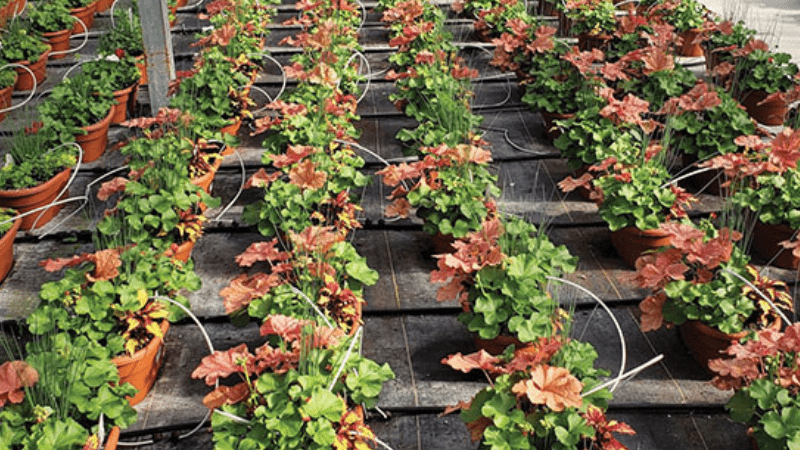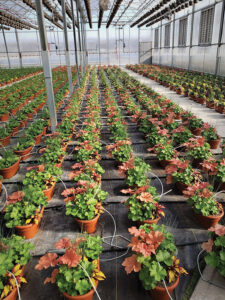
Technically Speaking: The importance of transpiration
Transpiration is the process of water movement from the roots to the shoots of plants. Just like photosynthesis and respiration, it is a requisite function for plant growth. In this article, the specific functions of transpiration are discussed, as well as the different cultural and environmental factors in controlled environments that can influence the process. As boring as transpiration may sound, understanding the process can provide fundamental insights into successful crop production.
Water and Nutrient Uptake

Water is absorbed as a liquid by roots, moves through the stems and leaves, and is lost as a vapor through very tiny openings on leaves called stomata. This transpiration process is passive, meaning it doesn’t require energy. Instead, the driving force for water movement is from the difference in water potential between the root zone and the atmosphere. The evaporation of water from leaves has the greatest impact on the rate of water uptake and movement through the plant. Minerals are dissolved in water and together, they move from the roots to the shoots. Therefore, nutrient uptake relies upon water uptake, which relies upon a healthy root system and a driving force for evaporation. When water uptake is slowed, such as from insufficient water in the substrate, a poor root system, or high humidity (low vapor-pressure deficit, or VPD), nutrient uptake is simultaneously decreased.
Evaporative Cooling
There are similarities between transpiration in plants and respiration, or sweating, in people. Just like people lose water through their bodies to cool themselves, plants “sweat” to cool their leaves. We sweat more, or lose more water, when the air is dry — high VPD — and when it’s sunny. Plants are the same; they lose more water as the VPD increases and as the amount of energy incident upon a leaf — from the sun or electric lamps — increases. If a plant or plant part does not adequately transpire water, it can overheat under high light and kill plant tissues.
Importance of Transpiration
The process of transpiration controls water and nutrient uptake as well as leaf and plant temperature. When water loss through the leaves begins to exceed what the roots can supply, plants respond by closing their stomata to limit water loss. When this happens, nutrient uptake slows down, plant temperature increases and uptake of carbon dioxide (CO2) decreases. Therefore, a water stress of any kind can decrease transpiration and slow down plant growth.
Relevance of VPD
As discussed in another article (tinyurl.com/water-vpd), VPD is the preferred way to quantify the driving force for water loss. At a very low VPD (less than 0.3 kPa), transpiration is slow because the driving force for water movement from the roots to leaves is slow. This is desirable during propagation of cuttings but not when plants have a well-developed root system. In contrast, at a high VPD (greater than 1.5 kPa), transpiration rate is high, which isn’t necessarily bad unless root uptake cannot meet the large amount of water lost through the leaves. When the transpiration rate cannot keep up, stomata close to limit water loss and the growth rate slows down. Therefore, in many controlled-environment production situations, a target VPD is between 0.5 and 1.5 kPa so that there is adequate but not excessive movement of water and nutrients through the plant via transpiration.
Influence of the Root Zone

Factors that limit the root uptake of water (and nutrients) limit transpiration. This can include inadequate moisture content of the substrate, excessive fertility or high salt content, a poorly developed root system, or a root pathogen such as pythium or rhizoctonia. INFLUENCE OF THE ENVIRONMENT In addition to VPD, the rate of transpiration can increase as drying conditions increase such as increasing temperature (which increases the VPD), light intensity and wind speed. High temperature and light intensity increase leaf temperature, which necessitates more evaporation of water to cool its surfaces. A high wind speed decreases the boundary layer around plants and thus increases the rate of leaf water loss.
Finally, a high concentration of carbon dioxide (CO2) in the air can decrease transpiration, since stomata don’t need to open as much for CO2 uptake. To conclude, management of the root zone and the growing environment controls transpiration, which ultimately regulates crop nutrition and plant growth. Except in specific situations (such as propagation), ultimately we want to provide the cultural and environmental conditions that lead to adequate but not excessive water uptake to promote growth and nutrient uptake.


 Video Library
Video Library 




















